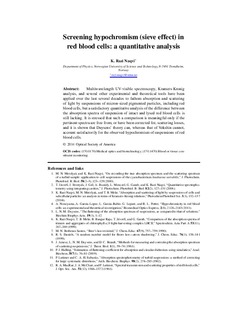Screening hypochromism (sieve effect) in red blood cells: a quantitative analysis
Journal article, Peer reviewed
Permanent lenke
http://hdl.handle.net/11250/2392243Utgivelsesdato
2014Metadata
Vis full innførselSamlinger
- Institutt for fysikk [2686]
- Publikasjoner fra CRIStin - NTNU [38056]
Sammendrag
Multiwavelength UV-visible spectroscopy, Kramers-Kronig analysis, and several other experimental and theoretical tools have been applied over the last several decades to fathom absorption and scattering of light by suspensions of micron-sized pigmented particles, including red blood cells, but a satisfactory quantitative analysis of the difference between the absorption spectra of suspension of intact and lysed red blood cells is still lacking. It is stressed that such a comparison is meaningful only if the pertinent spectra are free from, or have been corrected for, scattering losses, and it is shown that Duysens’ theory can, whereas that of Vekshin cannot, account satisfactorily for the observed hypochromism of suspensions of red blood cells.
